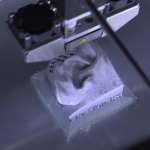Medically-based music therapy may soon lift spirits, brings smiles to Mass. Eye and Ear patients.
Mass. Eye and Ear recently announced an exciting new collaboration with Symphony New Hampshire. By partnering together, the hospital and professional orchestra are hoping to bring a medically based music therapy program to patients of Mass. Eye and Ear.
Music therapy programs benefit musicians, providers and institutions, but most importantly, they are grounded with the hope of improving patient care.
In fact, music therapy programs are known to:
- Decrease patients’ anxiety, stress, fear, pain and feelings of isolation while undergoing stressful medical care
- Promote relaxation, sensory stimulation, coping strengths and expression of emotion
- Bring normalcy to medical environments, and
- Provide patients with opportunities for choice and control; thus increasing patient compliance to treatment
Head and neck surgeon and Associate Chair of Otolaryngology at Mass. Eye and Ear Mark Varvares, M.D., previously established a music therapy program as a collaboration between the Saint Louis University Cancer Center, the Saint Louis University School of Medicine, SSM Health Saint Louis University Hospital, and the St Louis Symphony.
Since moving to Boston to work at Mass. Eye and Ear, Dr. Varvares has been laying the groundwork for a musical therapy program for our patients.
Music Therapy in Action
Here’s how it works: Board-certified music therapists complete in-depth assessments with patients to determine their musical preferences, needs and goals during treatment. They then provide one-on-one music therapy sessions throughout the patient’s treatment to address these needs, using specific music therapy interventions.
For example, one specific music therapy intervention adjusts the speed of music to a resting heart rate to increase relaxation and comfort while decreasing anxiety and stress. This specific music therapy intervention, known as entrainment, is currently being studied by Dr. Varvares and his collaborators at Saint Louis University.
Measuring the Clinical Outcomes of Music Therapy
While at the Saint Louis Cancer Center, Dr. Varvares was part of a research team led by Senior Music Therapist Crystal Weaver that developed studies to track the patient-perceived benefits of the music therapy program.
For example, in one study, they collected data on pulse, blood pressure and anxiety levels of patients receiving chemotherapy treatments. The subjects were split into three categories: patients who did not receive music therapy, patients who heard generic pieces from the live symphony and patients that received the targeted music therapy intervention, known as entrainment. The patients who received targeted music therapy had lower pulse, lower blood pressure and lower anxiety.
In another study, board-certified music therapists performed live music in a waiting room during a head and neck cancer outpatient clinic. A short survey was handed out to patients waiting in that area for their appointments. Of those surveyed, 100 percent preferred their clinic visit with live music .
“A Powerful Moment”
One new approach that the team developed was the selection of a song by a patient that was to undergo a bone marrow transplant.
Bone marrow transplantation, usually performed in patients who have malignancy involving their blood and bone marrow, is a climatic event that follows months of conditioning chemotherapy. The day of the transplant can be full of anxiety, anticipation and outright stress for the patient and their loved ones.
In this program, musicians from the St Louis Symphony performed a song selected by the patient live while nurse practitioners performed the bone marrow transplant (infusing cells into the patient’s veins). In this initial case, the musicians played their version of ‘Into the Mystic” by Van Morrison.
“It was a powerful moment, and there wasn’t a dry eye in the house, including mine,” said Dr. Varvares, who was present for the procedure.
A music therapy program at Mass. Eye and Ear would help us to further scientifically validate those experiences, and it is our hope that music therapy will become part of a regular hospital experience.
References:
An Introduction to Music Therapy Theory and Practice by William Davis, Kate Gfeller, and Michael Thaut, 2008
The Saint Louis University Cancer Center Music Therapy Program in the media
American Music Therapy Association



